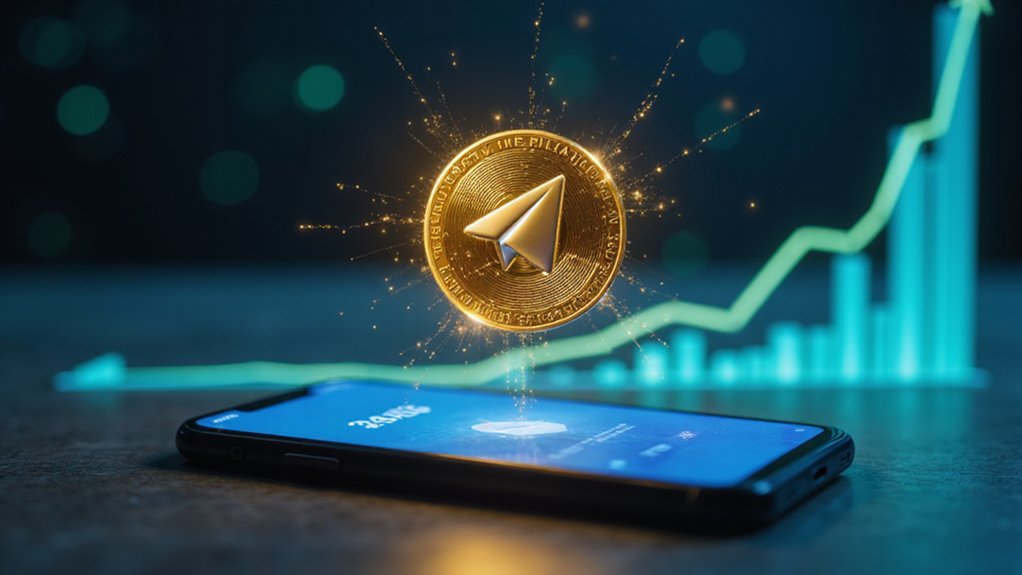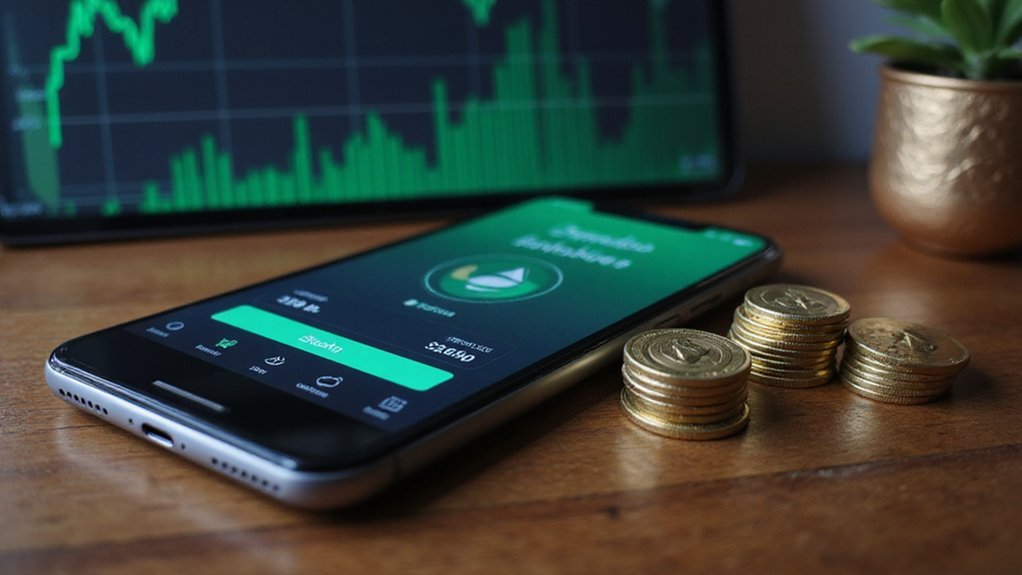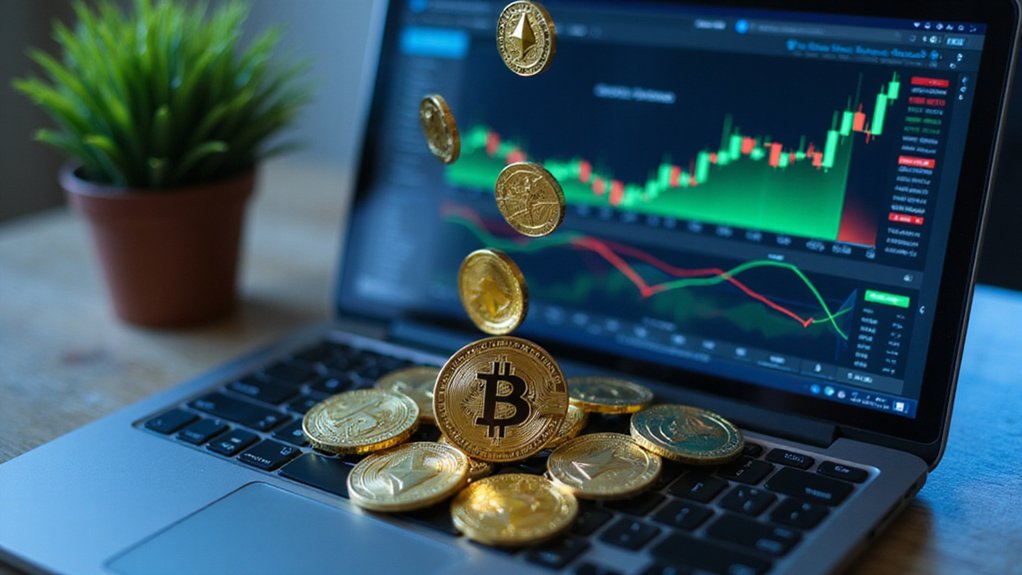Notcoin represents the peculiar intersection of mindless tapping and cryptocurrency speculation—a Telegram-based game where users accumulate virtual coins through repetitive screen taps. Launched by Open Builders on the TON blockchain, it transformed from simple tap-to-earn mechanics into a full-fledged cryptocurrency (NOT) with a remarkable $2.8 billion market cap. Its genius lies in gamifying blockchain adoption, converting 35 million players’ mundane tapping into tradable digital assets. The rabbit hole goes much deeper than mere screen-tapping.

What happens when you combine the addictive simplicity of a clicker game with cryptocurrency incentives and Telegram’s massive user base?
The perfect storm of gamification and blockchain—irresistible tapping meets crypto incentives within Telegram’s global playground.
You get Notcoin, a virtual cryptocurrency phenomenon that transformed from a humble tap-to-earn game into a full-fledged token with serious market presence.
Originally launched by Open Builders (a team led by Sasha Plotvinov) as a free game on Telegram, Notcoin’s premise was deceptively straightforward: tap a virtual coin, earn in-game currency.
Behind this apparent simplicity lies a sophisticated onboarding strategy for Web3 adoption.
Players accumulate in-game Notcoins through repetitive tapping, completing tasks, and utilizing power-ups like auto-tappers—all while managing an energy system that necessitates strategic play patterns.
What began as pure tap-to-earn eventually evolved into “explore-to-earn,” incentivizing users to interact with other projects in the broader ecosystem.
The NOT token reached an impressive $2.8 billion market cap shortly after its launch on June 2, 2024.
The game’s integration with The Open Network (TON) blockchain provides the technical foundation for its success.
Unlike traditional cryptocurrency mining, Notcoin employs play-to-earn dynamics rather than proof-of-work or proof-of-stake protocols.
TON’s architecture offers the speed and scalability needed to support Notcoin’s massive user base, which swelled to an impressive 35 million players by May 2024.
This blockchain integration culminated in the official NOT token launch on May 16, 2024, converting those countless hours of tapping into tangible cryptocurrency assets.
With a maximum supply of 102.7 billion tokens (78% allocated to early players), NOT quickly secured listings on major exchanges including Binance and KuCoin.
The social dynamics prove equally important; the game encourages squad formation, friend invitations, and leaderboard competition—mechanisms that contributed to its viral growth across Telegram’s ecosystem.
The platform applies a 1,000:1 conversion ratio from in-game Notcoins to NOT tokens, ensuring players receive proportional value for their gaming efforts.
Notcoin represents more than just another cryptocurrency; it’s a gamified portal into Web3 for millions who might otherwise remain disinterested in blockchain technology.
As Open Builders continues developing the Not Games platform, Notcoin stands as evidence that cryptocurrency adoption sometimes arrives not through technical innovation or financial necessity, but through the universal appeal of tapping a shiny digital object for rewards.
Frequently Asked Questions
How Do I Earn More Notcoins Faster?
To accelerate Notcoin accumulation, users should methodically upgrade their Multitap, Energy Limit, and Recharging Speed boosts while vigilantly catching rockets for Turbo Mode activation.
Completing tasks in the “Earn” section yields substantial rewards (often disproportionate to effort).
The Auto Tap Bot, available post-Silver League, generates passive income—a vital efficiency enhancement.
Building a robust referral network creates a multiplier effect, with each new recruit’s progress triggering cascading bonuses to the referrer.
Can Notcoins Be Converted to Real Cryptocurrency?
Yes, in-game Notcoins can indeed be converted to NOT tokens—a legitimate cryptocurrency—at a rate of 1,000 Notcoins per 1 NOT.
Once converted, these tokens trade on major exchanges like Binance and KuCoin against established pairs including USDT and BTC.
NOT operates on the TON blockchain with significant market presence (exceeding $1B market cap post-launch) and real-world value (approximately $0.0018 USD per token).
This conversion pathway transforms gameplay tapping into potentially tradable assets.
Is There a Daily Limit to Notcoin Mining?
Notcoin doesn’t impose a strict daily mining limit measured in coins; rather, it employs an energy-based constraint system.
Players can tap until their energy depletes, after which mining halts until regeneration occurs.
This creates a de facto ceiling on daily production—less a hard cap than a throttling mechanism.
Various boosters (Energy Limit, Recharging Speed, Full Energy refills) strategically expand these boundaries, allowing players to optimize their mining efficiency within the system’s cleverly designed constraints.
Will Notcoin Be Listed on Exchanges?
Notcoin (NOT) is already listed on multiple major exchanges as of May 16, 2024.
The token simultaneously launched on Binance, OKX, Bybit, KuCoin, Gate.io, and Bitfinex—an impressive debut for a gaming token.
Pre-listing activities included Binance’s Launchpool and OKX’s Jumpstart events, distributing billions of tokens.
NOT achieved remarkable initial performance with over $1.27 billion in 24-hour trading volume and quickly reached a $1B+ market cap, though price subsequently declined as airdrop recipients liquidated positions.
How Does Notcoin Compare to Other Tap-To-Earn Games?
Notcoin distinguishes itself in the saturated tap-to-earn ecosystem primarily through its successful execution rather than revolutionary mechanics.
While sharing fundamental features with competitors like Hamster Kombat and TapSwap (energy systems, upgrade paths, task completion), Notcoin‘s integration with TON blockchain and subsequent exchange listings on major platforms like Binance have cemented its position.
Its 35-million-strong user base, though dwarfed by Hamster Kombat’s claimed figures, has translated into more sustainable tokenomic performance than many of its more ephemeral rivals.









